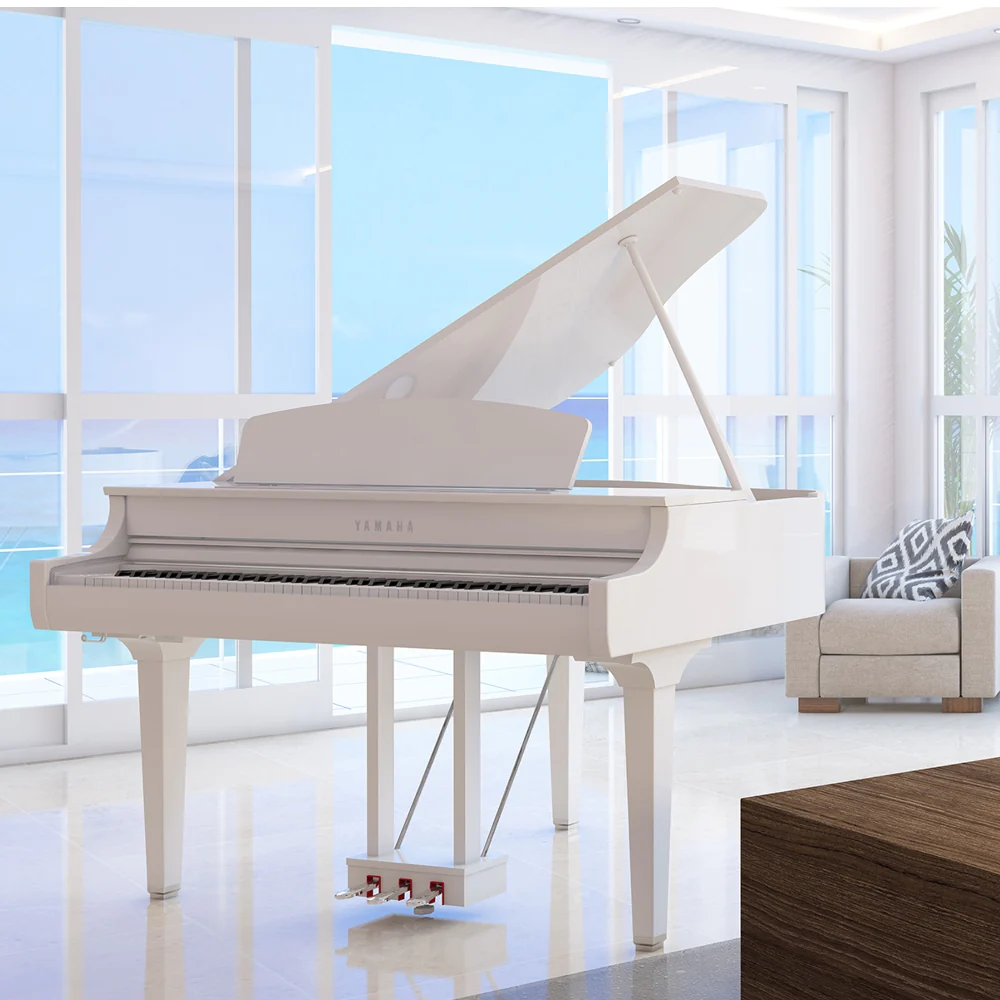Are you a music lover looking to add a new instrument to your collection? Or maybe you’re just starting out on your musical journey and are curious about different types of pianos. Well, look no further! In this article, we’ll be discussing the console piano – what it is, how it differs from other types of pianos, and why you should consider adding one to your repertoire. Whether you’re an experienced player or a beginner, read on to learn all about this beautiful and versatile instrument that could be the perfect addition to your home. So let’s explore the world of console pianos together!
So, what is a console piano?
A console piano is a type of upright piano that typically stands between 40-44 inches tall. It is smaller and more compact than a grand piano, making it suitable for smaller spaces such as apartments or homes.
There are several reasons why you should consider buying a console piano. Firstly, its size makes it more affordable compared to larger pianos, making it a great option for beginners or those on a budget. Additionally, its compact design allows for easier transportation and placement within your home.
Furthermore, console pianos often have a warm and rich sound quality that can rival that of larger pianos. They also offer the same range of keys and capabilities as other types of pianos.
Another benefit of owning a console piano is its durability and low maintenance needs. Due to their vertical construction, they take up less space but still provide excellent sound quality without needing frequent tuning.
Overall, if you are looking for an affordable yet high-quality instrument with versatility and convenience in terms of space-saving features, then investing in a console piano may be the perfect choice for you.
Understanding the Basics of a Console Piano
When it comes to the world of pianos, a console piano is like a hidden gem. It doesn’t have the towering presence of a grand piano or the compact size of an upright model but sits comfortably in between. A console piano typically stands about 40-43 inches tall, making it slightly larger than its spinet and studio relatives. Its moderate size allows for longer strings and more voluminous soundboard, which directly contribute to its superior tonal quality.
The key components that make up a console piano include:
The Cabinet: Not only does this house all the other parts, but it also adds to your room’s decor.
The Keyboard: This is where you’ll create music by pressing on its 88 keys.
Hammers & Strings: This gives each note you play its unique sound.
- Felt-covered hammers strike steel strings when you press down on keys.
- Different string thicknesses produce different pitches – thin ones for high notes and thick ones for low notes.
By understanding these basics about console pianos, anyone can appreciate their stylish design without feeling overwhelmed by their majestic counterparts — full-sized grand pianos. So next time you come across one in someone’s living room or even at your local music store – take a moment to admire not just what meets the eye but also what lies beneath!
Distinguishing Features of a Console Piano
The console piano is a work of art, in both its intricate design and the delightful harmonies it produces. This piano variety is smaller than most grand or upright pianos but don’t let that fool you! Its fascinating features will leave every music aficionado enthralled.
This musical marvel typically stands at a height between 40 to 43 inches tall. With less vertical space compared to other pianos, console pianos bear compact hammers, strings and soundboards which generate beautiful yet subtly quieter tones. The casing of a console piano isn’t just for decoration either – its well-crafted wooden structure contributes to the instrument’s rich resonance. These alluring sounds are produced by striking keys on the front panel which come in sets of 88 standard white and black keys.
The console piano clearly flaunts distinct characteristics that set it apart from other musical instruments.
The unique aspects of this interface don’t stop there though! Console pianos often feature:
- An internal mute pedal that allows users to play quietly without disturbing others,
- A ‘direct blow’ action where the hammer strikes directly upwards towards the strings,
- A stylish cabinet design lending an elegant aesthetic appeal, making it much more than just an instrument – it’s also a piece of furniture!
Console pianos really do pack quite an impressive punch with their exquisite blend of wonderful tonality, fine craftsmanship, and sophisticated aesthetic appeal. It’s no wonder they’re loved by many musicians around the world!
Read also: what is a console piano
Benefits of Owning and Playing a Console Piano
Owning a console piano can be likened to having your private orchestra. As an owner, you’re privy to a plethora of benefits that extend beyond the simple pleasure of playing music. For starters, having this noble instrument right in your living room or any other part of your house adds an elegant touch, turning even the most mundane spaces into opulent corners. The rich and vibrant sounds emanating from a console piano are not only soothing but also uplifting, with the power to transform dreary afternoons into vibrant symphonies.
Apart from its aesthetic appeal and musical charm, owning and playing a console piano comes packed with numerous additional perks:
- Mental workout: Playing this instrument is akin to giving your brain a full-blown exercise session – it enhances hand-eye coordination, improves concentration while boosting memory.
- Creative Boost: Mastering different tunes on the console piano can ignite creativity within you like no other activity.
- Social Benefits: You’ll find that people love gathering around for live performances – instantly making you everyone’s favorite host!
The advantages don’t stop there; they spill over into your emotional well-being too. Playing familiar melodies offers comfort during tough times while learning new ones brings about feelings of accomplishment. Overall, owning and playing a console piano provides multiple layers of rewards – enhancing mental agility whilst enriching life with beautiful music.
 what is a console piano
what is a console piano
Comparing the Console Piano to Other Types of Pianos
The world of pianos is a vast and fascinating one, with each type of piano having its unique characteristics. At the heart of this diverse array, you will find the console piano. It stands proudly as a common choice for many due to its appealing blend of compact size and robust sound. In comparison to other types like the grand or upright pianos, console pianos are smaller in stature yet do not compromise on their tonal quality.
Let’s delve deeper into some facets that differentiate console pianos from others. Compared to grand pianos,
- Size: Console pianos often measure around 40-43 inches tall whereas grand pianos can range from 4.5 feet up to an impressive 9 feet long.
- Sound Quality: While grand pianos may provide greater volume and resonate more vibrantly due to their larger soundboards, console owners argue that they have enough power for most living spaces while offering richer tones when placed correctly.
- Affordability: A noteworthy point is that specifically compared to high-end grands, console models are significantly more affordable making them accessible for budget-conscious music lovers.
On the other hand when juxtaposed against uprights—another popular household choice; bear in mind two things:The first being that both these types visually look similar but not identical—the former tends towards a sleeker design—aesthetically pleasing.
The second major difference lies in their key actions—with consoles employing a direct blow action—an attribute which provides players with greater control over nuances during playing. So there we have it: whether it’s functionality or aesthetics—you’ll see why choosing between different kinds of keyboards boils down largely—pun intended—to personal preferences!
You may also like: where is yamaha piano made
Choosing the Right Console Piano for Your Needs
Choosing the right console piano for your unique needs can feel a bit like hunting for buried treasure, but don’t worry! This worthwhile journey is filled with enchanting melodies and harmonious chords that will soothe your soul in no time. Each console piano has distinct characteristics, from their silky-smooth keys to the depth of their resonant sound. The sheer variety can seem overwhelming at first, especially if you’re new to this magical world of music making.
So where should you start? Consider your personal preferences. Are you more inclined towards warm tones or bright ones? What size would fit comfortably into your space without turning it into an echo chamber? If these questions perplex you, do not fret! Let’s break down some factors one by one:
- Tone Quality: As the heart and soul of any piano, tone quality largely defines its overall character. Bright tones are often associated with pop or jazz styles while warmer tones serve classical tunes best.
- Size:The size of a console piano plays a significant role in determining both its sound volume and aesthetic appeal within your space.
- Digital vs Acoustic:If silence is paramount (for instance if you live in an apartment), consider opting for digital pianos as they come equipped with headphone jacks!
Remember that choosing the right instrument is about finding harmony between your musical goals and practical constraints. Have patience during this process; after all, great symphonies aren’t composed overnight! And most importantly – let yourself be guided by what sounds beautiful to
Conclusion: The Value and Versatility of a Console Piano
In a world that is constantly moving towards smaller, sleeker designs in almost everything, the console piano continues to hold its ground as an essential piece of musical equipment. These remarkable instruments are not only beautiful and affordable, but they also offer incredible versatility for both beginners and seasoned pianists alike.
The beauty of a console piano extends beyond its physical appearance. It’s powerfully expressive and can produce rich tones that resonate deeply with the listener. The keys respond directly to your touch – play softly for a whimsical whisper or strike forcefully for an intense roar; this allows you to express your emotions through music eloquently.
The large size often means better sound quality because there’s more room for strings, giving it warm acoustics so each note lingers pleasantly in the air.
Apart from their acoustic qualities, console pianos also bring immense value to learners at various stages of their musical journeys. Their compact design makes them ideal for small spaces such as living rooms or bedrooms without compromising on sound quality.
- For beginners, learning on a console provides the opportunity to learn how different touches affect tone production: soft pressing produces softer tones while harder pressing gives louder sounds.
- For intermediate players, it offers opportunities to explore intricate compositions with dynamic ranges exceeding those of digital keyboards.
- Experienced musicians appreciate the subtleties offered by these full-sized instruments like variations in key resistance which aren’t available on many modern synthesizers.
In summary, whether you’re just starting out or have been playing for years, owning a console piano offers undeniable richness both aesthetically and musically . A worthy investment indeed!

